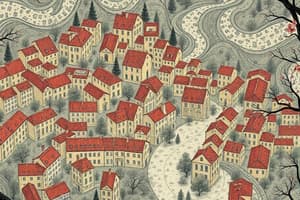Podcast
Questions and Answers
Cities can vary in size, shape, layout, and socioeconomic balance due to factors like urban __________.
Cities can vary in size, shape, layout, and socioeconomic balance due to factors like urban __________.
migration
____ geography focuses on cities, towns, and densely populated areas.
____ geography focuses on cities, towns, and densely populated areas.
Urban
____ geography studies agriculturally dominant regions and smaller communities.
____ geography studies agriculturally dominant regions and smaller communities.
Rural
To better understand urban dynamics, geographers may analyze aspects like land value __________.
To better understand urban dynamics, geographers may analyze aspects like land value __________.
In the study of human settlement geography, the central concepts of site and _________ are essential.
In the study of human settlement geography, the central concepts of site and _________ are essential.
_______ landscapes showcase various landforms like valleys, rolling hills, and ridges, each influencing farming techniques and local economies.
_______ landscapes showcase various landforms like valleys, rolling hills, and ridges, each influencing farming techniques and local economies.
Understanding the interplay of biological, ecological, social, and economic determinants is crucial when studying _______ settings.
Understanding the interplay of biological, ecological, social, and economic determinants is crucial when studying _______ settings.
Urbanization involves the shift of populations away from low density rural areas toward more concentrated _______ environments.
Urbanization involves the shift of populations away from low density rural areas toward more concentrated _______ environments.
Site refers to the location of a specific settlement based on physiographic features such as elevation, climate, soil composition, and _______.
Site refers to the location of a specific settlement based on physiographic features such as elevation, climate, soil composition, and _______.
Situation describes how well a settlement fits in relation to surrounding places, enhancing integration, fostering collaboration, facilitating trade, and ensuring convenient _______ options.
Situation describes how well a settlement fits in relation to surrounding places, enhancing integration, fostering collaboration, facilitating trade, and ensuring convenient _______ options.
Flashcards are hidden until you start studying
Study Notes
Human Settlement Geography
Human settlements, spanning from bustling metropolises to tranquil villages, have always been intriguing subjects within the realm of geography due to their diverse forms, growth patterns, and influences on the environment. In this exploration of human settlement geography, we'll delve into three main areas — urban geography, rural geography, and urbanization — while also shedding light on the central concepts of site and situation.
Urban Geography
Urban geography focuses its lens on cities, towns, and other densely populated areas. These spaces are characterized by high concentrations of economic activity, infrastructure, and social interactions. Cities can vary drastically in size, shape, layout, and socioeconomic balance; they arise through complex processes involving factors such as urban migration, land value taxation, historical legacy, and political decisions.
City neighborhoods often reflect both physical characteristics, like topography and natural barriers, and social components, such as ethnic backgrounds and cultural identities. To better understand these dynamics, geographers may analyze aspects including land value taxation, accessibility, and transportation networks.
Rural Geography
The study of rural geography looks beyond city borders at agriculturally dominant regions where people typically live in smaller communities, working with livestock, crops, or forestry resources. This field emphasizes understanding relationships between individuals, households, farms, and the broader landscape. It explores topics related to land tenure systems, agricultural practices, environmental conservation efforts, and resource distribution.
Rural landscapes showcase various landforms like valleys, rolling hills, and ridges, each influencing farming techniques and local economies. Understanding the interplay of biological, ecological, social, and economic determinants is crucial when studying rural settings.
Urbanization
A burgeoning global population, coupled with rapid industrialization and increasing wealth, drives a phenomenon known as urbanization. This process involves the shift of populations away from low density rural areas toward more concentrated urban environments. Though urbanization has facilitated tremendous advancements in human welfare and material prosperity, it poses challenges for managing public health, waste disposal, traffic congestion, and housing affordability.
Geographical inquiries into urbanization encompass examining demographic trends, the role of transportation networks, and assessing spatial implications for new development projects. By analyzing these elements, researchers can offer valuable perspectives on optimizing future urban planning policies and address current issues related to sustainable living conditions.
Site & Situation
Site refers to the location of a specific settlement based on physiographic features such as elevation, climate, soil composition, and microclimate. A building's site must possess attributes suitable for its intended purpose or risk facing problems ranging from flooding during heavy rainfall to poor winter illumination.
Situation, on the other hand, describes how well a settlement fits in relation to surrounding places. Ideal situations enhance integration, foster collaboration, facilitate trade, and ensure convenient commuting options while minimizing negative externalities. Examples might include a town located near an international airport or a village situated alongside major roads leading to nearby industrial hubs.
In conclusion, human settlement geography offers insightful glimpses into our diverse urban and rural landscapes. By exploring and applying principles of site selection, situational analysis, urbanization phenomena, and distinct facets of urban and rural geography, geographers contribute indispensable knowledge towards improving quality of life and sustainable development across all types of human habitats.
Studying That Suits You
Use AI to generate personalized quizzes and flashcards to suit your learning preferences.




